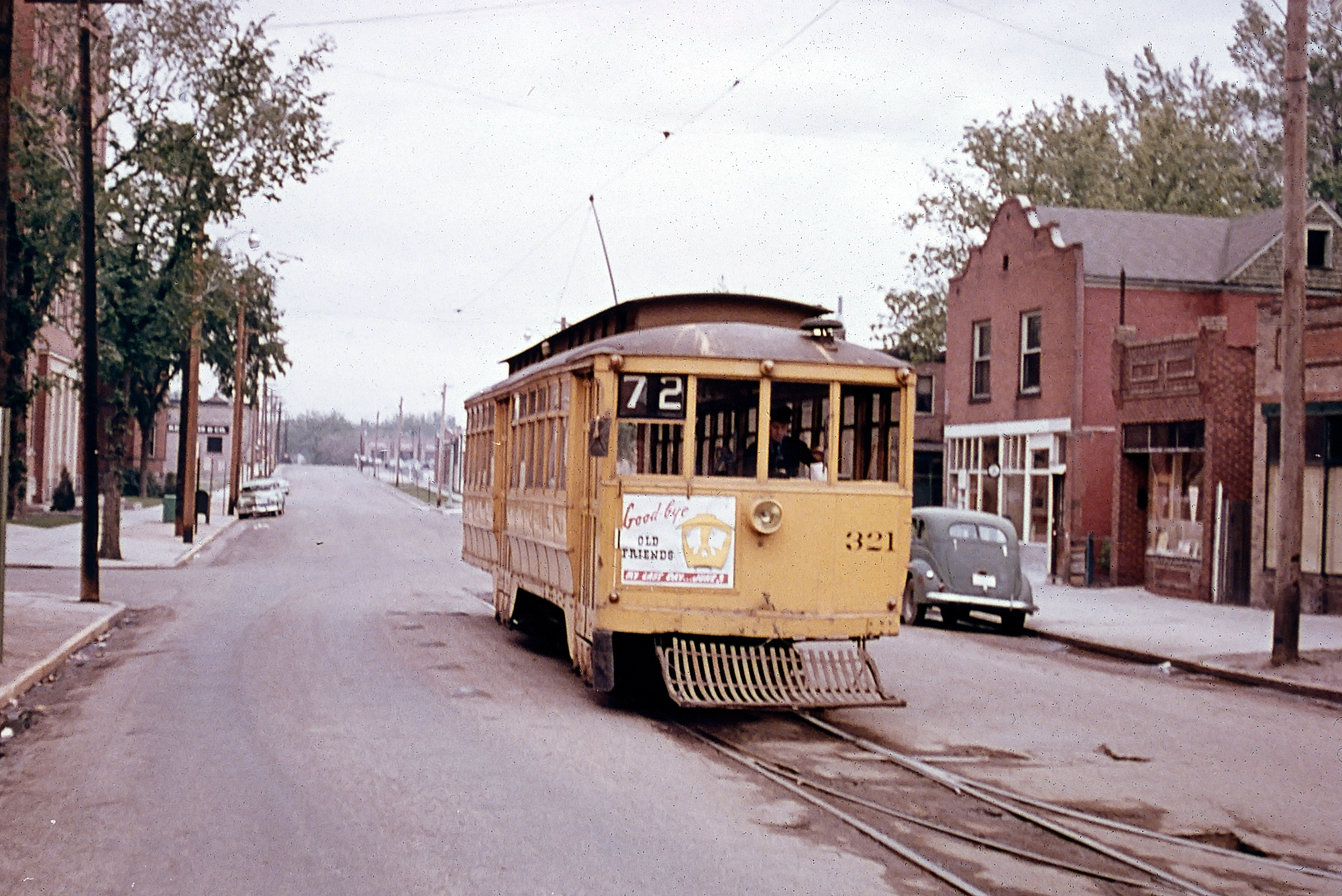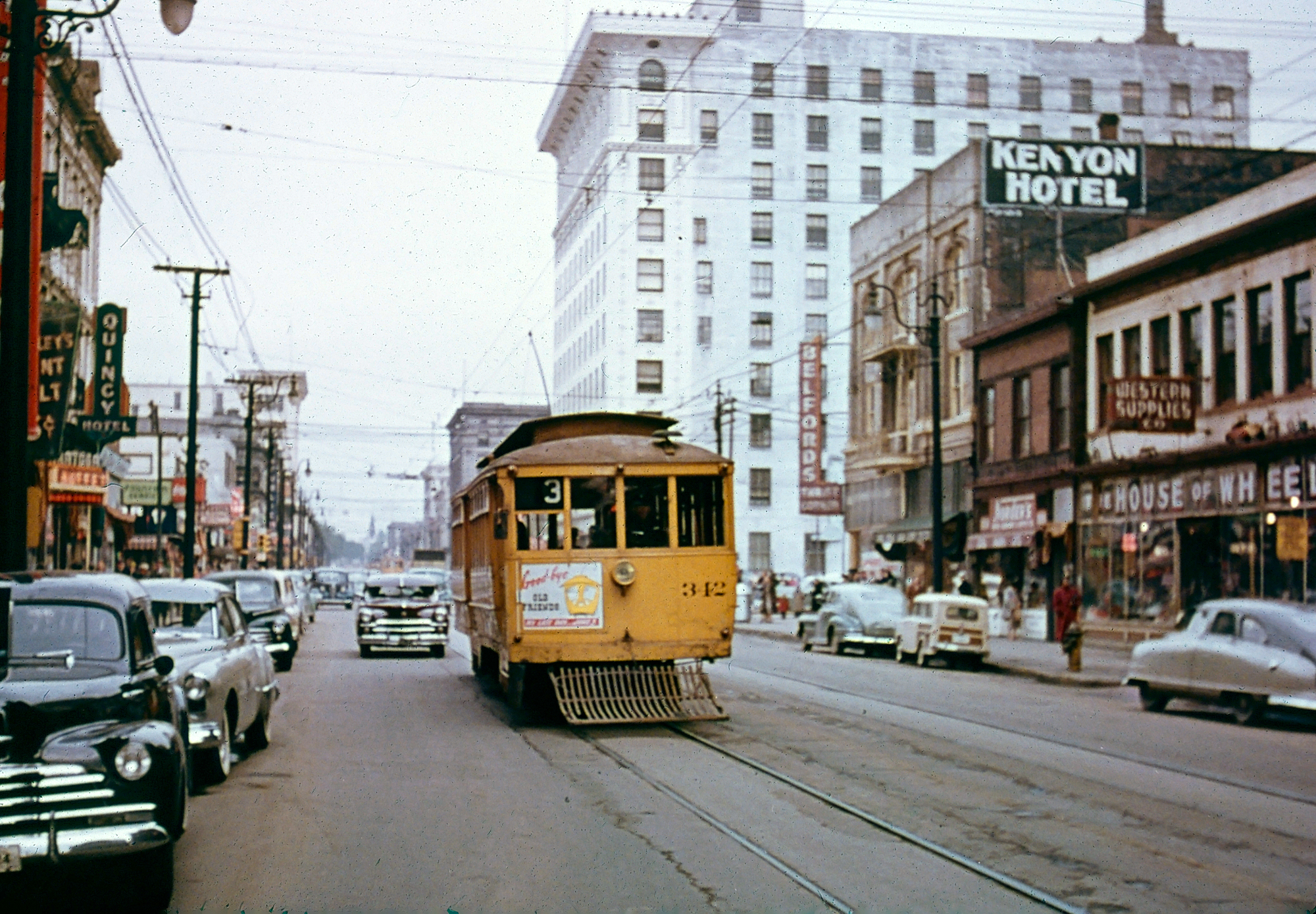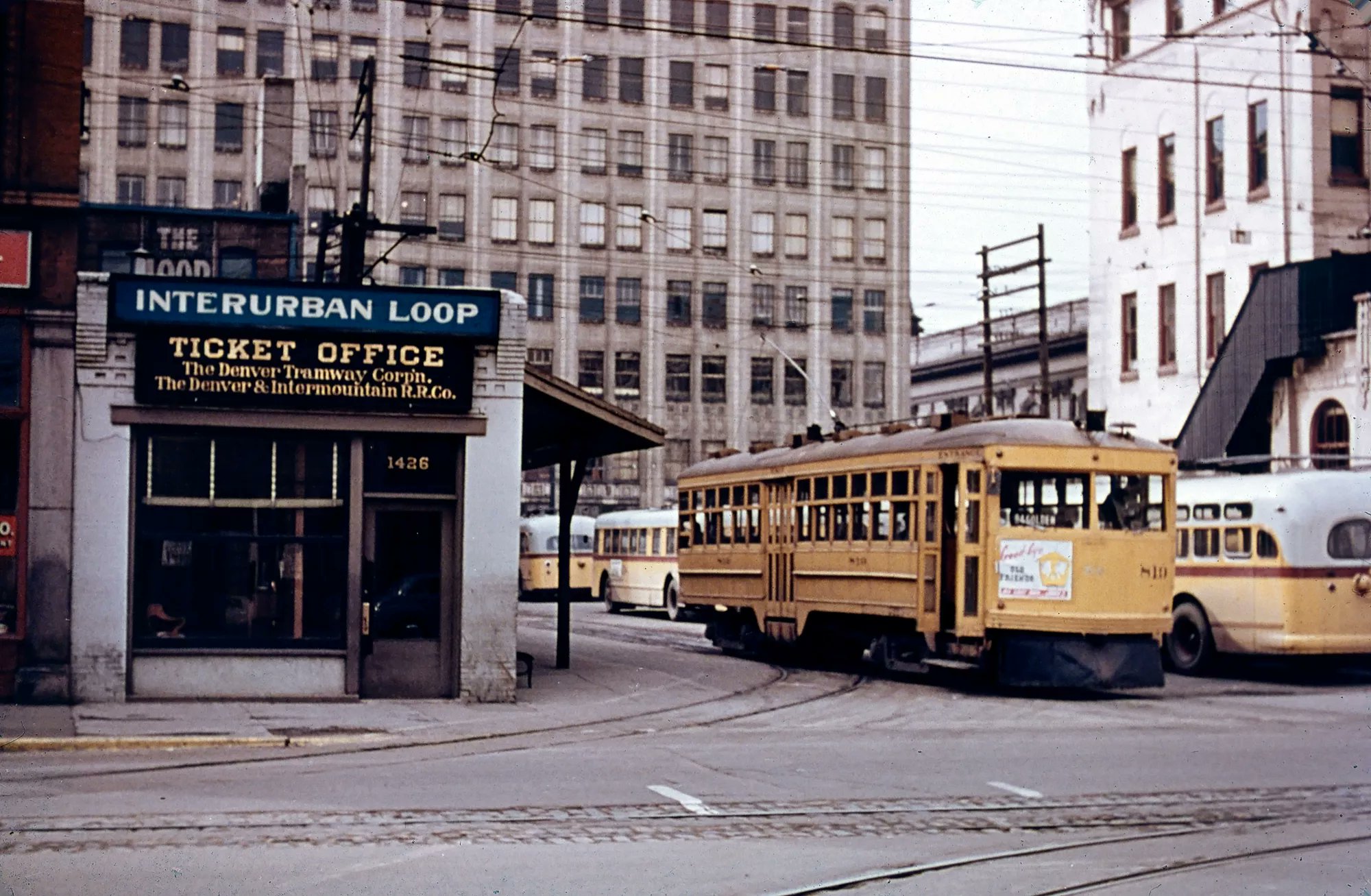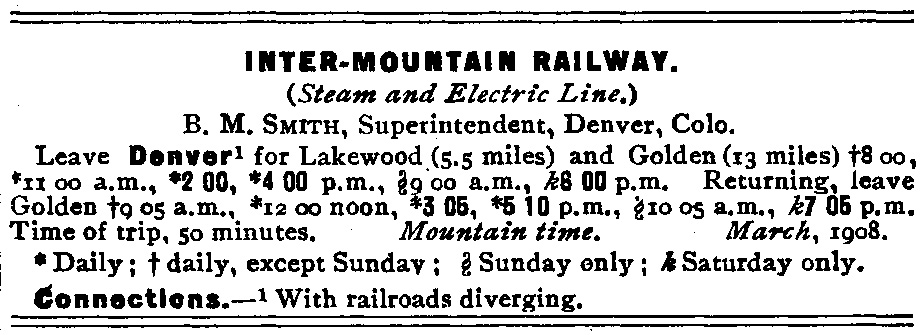Denver and Intermountain Railroad: Routes, History, Photos
Last revised: September 6, 2024
By: Adam Burns
The Denver and Intermountain Railroad (D&IM) has a storied past that intertwines with the growth of Colorado and the development of the region's transportation infrastructure.
It began in the late 19th century as an ambitious effort to connect Denver with its surrounding communities, aiding not only in passenger travel but also in economic exchanges that were vital during the times of rapid urban and industrial growth.
The line's ownership transferred to Associated Railroads after operations had ended in the early 1950s, which operated it for freight services up to the Denver Federal Center.
In the 1990s, the Regional Transportation District acquired the right-of-way and rehabilitated it, incorporating it into the W Line light rail system. Thus, the legacy of the Denver and Intermountain Railroad continues to influence Denver's modern transit landscape.
 Denver & Intermountain car #321 runs Route 72 on Delaware Street in Denver, Colorado in the spring of 1950, just before passenger operations ended on the interurban. Freight service was retained to Golden until March 15, 1953. American-Rails.com collection.
Denver & Intermountain car #321 runs Route 72 on Delaware Street in Denver, Colorado in the spring of 1950, just before passenger operations ended on the interurban. Freight service was retained to Golden until March 15, 1953. American-Rails.com collection.The Denver and Intermountain Railroad (D&IM), an interurban railway, spanned an 18-mile (29 km) route between Denver and Golden, Colorado.
Initially known as the Denver, Lakewood and Golden Railroad, this steam-powered line began operations in 1891 and completed an electrified spur into downtown Denver by 1893.
Facing financial difficulties, the company was placed into receivership and acquired by the Denver & Inter-Mountain Railway in 1904. It underwent several name changes, becoming simply the Intermountain in 1907 and finally the Denver & Intermountain Railroad (D&IM) in 1910.
In 1909, the line was fully electrified with 11,000 volts alternating current, facilitating direct trains to navigate city streets and reach downtown Denver's Interurban Loop.
The following year, the Denver Tramway acquired the company, integrating it into their system as Route 84. Passenger service continued until 1950, although the electrical infrastructure was maintained until 1953.
Origins and Early Years (1890-1900)
The seeds of the D&IM's creation were sown in the bustling era post-Reconstruction, as America pursued westward expansion and industrial progress.
In 1890, the Denver, Lakewood and Golden Railroad Company was formed. The endeavor aimed to link Denver with Golden, a burgeoning town known for its commercial significance and proximity to the Rocky Mountains.
With high hopes and considerable capital, tracks began being laid, and the company saw its first passenger service operation within the same year.
Using steam engines, the initial segments of the railroad catered to the suburban commuters traveling between Denver and Lakewood—catering to both urban workers and those seeking leisure in the less populated outskirts.
Despite the excitement and the promise of financial returns, the railroad company faced stark competition from other forms of transportation and stiff economic challenges.
Rebirth and Resilience (1901-1920)
Around the turn of the century, electric railways began to emerge as a more reliable and cost-efficient alternative to steam power.
The Denver, Lakewood and Golden Railroad adapted to these advances through a series of reorganizations and mergers, ultimately resulting in the formation of the Denver and Intermountain Railroad Company in 1904.
This renaissance was pivotal. With the transition to electric trolleys in 1909, the D&IM could offer more frequent services and lower operational costs, attracting a greater number of commuters and contributing to the growth of Denver's suburbs.
The electrified system gained popularity, connecting several key districts, and ultimately extending beyond Golden to include other small towns and communities.
One notable achievement during this period was the construction of the Jewell Avenue Line, a strategic extension that improved accessibility to areas south of Lakewood.
By integrating seamlessly with Denver's urban transit systems, the D&IM created a cohesive network that spurred urban development and economic growth in the region.
The Golden Age (1921-1940)
The 1920s and 1930s marked the peak of the D&IM's operations. These were the halcyon days of electric interurban railways in America, driven by an increased demand for efficient public transport systems amid the country's urban expansion.
D&IM's fleet of trolleys serviced both commuters and tourists, facilitating travel to scenic sights and recreational destinations, including connections to the Denver Tramway system.
D&IM's Golden Line was perhaps one of the most famous routes, offering picturesque views as it traversed the landscape between Denver and Golden. It was not merely a transit route but a link that symbolized the union of urban development with the natural beauty of Colorado.
At its zenith, the D&IM operated dozens of cars, and plans were continually drawn up to further extend the network.
Notably, the company pioneered several technological innovations to improve service quality, such as the introduction of larger passenger cars and the optimization of electric power systems.
Community fairs and events often saw special services chartered, making the D&IM an integral thread in the social fabric of the region.
 Denver & Intermountain car #342 is on 15th Street in Denver in the spring of 1950 shortly before the interurban ended passenger services. American-Rails.com collection.
Denver & Intermountain car #342 is on 15th Street in Denver in the spring of 1950 shortly before the interurban ended passenger services. American-Rails.com collection.Challenges and Competition (1941-1960)
World War II presented both opportunities and challenges for the D&IM. The war effort necessitated robust transport systems to ensure the mobility of workers and resources.
However, on the other hand, the company faced material shortages, increased operational costs, and competition from the rapidly expanding road transport system.
Post-war America entered an era characterized by widespread automobile ownership and the construction of extensive highway systems.
These societal shifts led to a steady decline in ridership for many interurban railways, including the D&IM. Despite strategic attempts to modernize the fleet and improve service conditions, the convenience and individualism of car travel began to overshadow the communal benefits of trolley systems.
Efforts to diversify services were met with mixed results. Cargo transport, a potential revenue booster, failed to compensate for the dwindling passenger numbers. Moreover, increasing suburban sprawl required infrastructure investments that the company struggled to meet.
Decline and Transition (1961-1980)
The latter half of the 20th century marked a period of tremendous change and eventual decline for D&IM.
By the early 1960s, operational costs had skyrocketed, and a significant portion of the infrastructure required critical repairs that were financially unfeasible.
The rail company's core service premise was being eroded by an entrenched preference for automobile travel and the convenience of domestic air travel for longer distances.
Faced with insurmountable competition, the D&IM ceased its passenger services in 1950, focusing on freight operations in a bid to stay relevant.
However, freight services also faced stiff competition from trucking companies leveraging the burgeoning highway network. Despite best efforts to repurpose assets, the decline was irreversible.
In the late 1970s, segments of the old D&IM infrastructure were decommissioned, with parts of the rail segments being repurposed or abandoned.
The increasing shift to more flexible and faster modes of transport underscored the limitations of the interurban railways formulated in an era predating such ubiquitous automotive culture.
Legacy and Preservation (1981-Present)
Though the D&IM ceased operations in the late 20th century, its legacy lives on. The history of this interurban railway is preserved through various historical societies and museums dedicated to Colorado’s rich transportation heritage.
Enthusiasts and preservationists have ensured that future generations comprehend the significance of the D&IM in fostering regional development and connecting communities.
Several initiatives have been undertaken to commemorate the D&IM’s contributions. Historical markers and restored trolley cars can be found in museums and along original service lines, providing educational insights and sparking nostalgia for a bygone era of transportation.
One such organization, the Colorado Railroad Museum, houses a wealth of artifacts, photographs, and restored railway cars that narrate the tale of the D&IM.
These preserved relics offer invaluable glimpses into the social and economic impact of the railway during its operational heyday, underlining the D&IM’s role in the broader narrative of American industrial progress.
Modern-day light rail and commuter rail systems in Denver owe a nod to their early predecessors like the D&IM. The knowledge gained and lessons learned from early interurban operations have indubitably informed contemporary urban rail transit planning and execution.
Today’s efficient, electrified urban and regional rail systems stand on the shoulders of the pioneering efforts of early 20th-century systems.
 The Denver & Intermountain's ticket office and downtown loop in Denver, circa 1953. American-Rails.com collection.
The Denver & Intermountain's ticket office and downtown loop in Denver, circa 1953. American-Rails.com collection.Conclusion
The history of the Denver and Intermountain is a narrative of ambition, innovation, adaptation, and resilience. From its origins as the Denver, Lakewood, and Golden Railroad to its peak operations and eventual decline, the D&IM symbolizes a transformative era in American transportation history.
It connected urban centers with suburban and rural communities, aiding economic expansion and improving quality of life.
Though it ultimately succumbed to newer forms of transportation, its legacy is preserved and celebrated, ensuring that the D&IM remains an indelible chapter in the annals of Colorado and American railway history.
Recent Articles
-
New York - Murder Mystery - Dinner Train Rides
Dec 13, 25 10:30 AM
New York State, renowned for its vibrant cities and verdant countryside, offers a plethora of activities for locals and tourists alike, including murder mystery train rides! -
Pennsylvania - Murder Mystery - Dinner Train Rides
Dec 13, 25 10:25 AM
Pennsylvania, steeped in history and industrial heritage, offers a prime setting for a unique blend of dining and drama: the murder mystery dinner train ride. -
Ohio - Murder Mystery - Dinner Train Rides
Dec 13, 25 10:14 AM
The murder mystery dinner train rides in Ohio provide an immersive experience that combines fine dining, an engaging narrative, and the beauty of Ohio's landscapes.




